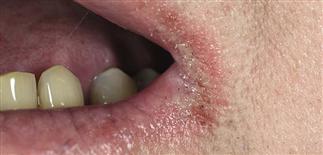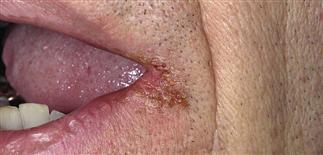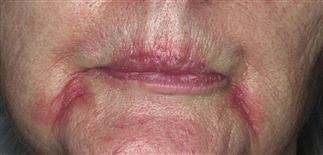73
Angular cheilitis

Dry skin in winter and repeated lip licking predispose to inflammation. Group VI topical steroids and petrolatum-based barrier protectants may control early cases.

Mixed infection evolves after several weeks. Ketoconazole cream, mupirocin ointment, and group VI topical steroids (to suppress inflammation) are used in rotation every 6 h to treat yeast and bacteria.

Saliva is drawn into perioral skin folds of the elderly. Repeated wetting–drying cycles chap and inflame the skin. Daily applications of petrolatum-based lubricants may protect fold from moisture.

Skin folds beyond the angles of the mouth may also become moist with saliva. Topical antibiotics, antiyeast creams, and group VI topical steroids may all be needed. A cool wet compress is very effective.
DESCRIPTION
Inflammation at the angles of the mouth is called perlèche or angular cheilitis. The problem occurs most often in the elderly. It becomes a chronic source of discomfort.
HISTORY
• A moist, intertriginous space forms in skin folds at the angles of the mouth as a result of advancing age. Photodamage leads to deep facial and perioral wrinkles. Saliva flows into the angles, especially during sleep. Repeated cycles of wetting and drying chap the angle. Licking causes progression to eczema and secondary mixed infection with Candida organisms and/or staphylococci. • Recurrence is common, because the anatomic defect is not easily corrected. • The constant irritation, pain, and itching is very distressing. • Patients taking isotretinoin develop severe dry lips and angular cheilitis. • Young habitual lip lickers, especially atopic patients, are at risk.
PHYSICAL FINDINGS
• Older patients develop a deep crease in the skin at the mouth angle. Wetting leads to drying and cracking. Licking accelerates the drying, and eczema develops with erythema and scaling. • Chronically inflamed skin becomes infected with staphylococci, which produce papules and pustules. Chronically wet skin is a breeding ground for Candida species. • Painful fissures occur at the base of the skin fold. Further progression leads to erosions and ulceration. • Culture skin that does not respond to standard therapy.
TREATMENT
A combination of medications is usually required. Yeast, bacteria, and eczema must be controlled. • Yeast is treated with the twice-daily application of clotrimazole, miconazole, ketoconazole, or econazole. • A group V–VI steroid cream or lotion, such as desonide lotion 0.05%, is applied 4 h later and used twice each day. Non-steroidal anti-inflammatory agents such as Elidel 1% cream or Protopic ointment 0.1% are not as effective as steroid creams for controlling acute inflammation but may be useful for maintaining control in chronic cases. • Secondary bacterial infection responds to mupirocin ointment or oral antibiotics active against staphylococci. • Stop treatment when inflammation is controlled. Then protect the angles with heavy lubricants such as lip balm (Chapstick) or ointment (Aquaphor, or plain petrolatum or zinc oxide 20% ointment). Use during the day and at bedtime.







